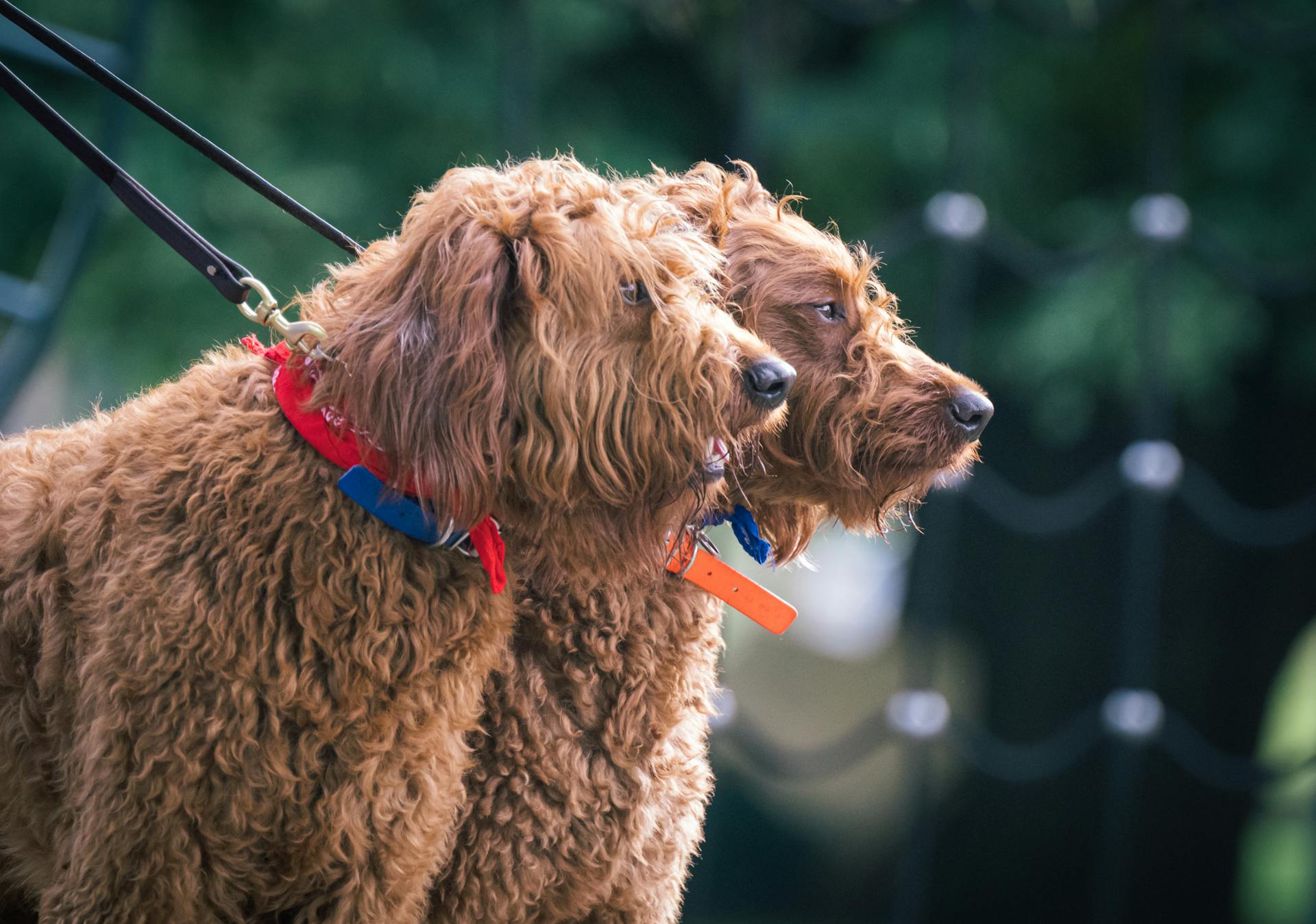
Labradoodles are a cross between a Labrador Retriever and a Poodle, typically an Australian or Standard Poodle. This unique blend of breeds creates a highly intelligent and energetic dog.
Their intelligence is one of the most notable characteristics of Labradoodles, making them highly trainable. With proper training and socialization, they can excel in various roles, from service dogs to family pets.
Labradoodles are often considered hypoallergenic due to their low-shedding coat, which is a result of their Poodle heritage. This makes them a great choice for families with allergy concerns.
Labradoodle Basics
Labradoodles are a popular choice for families and individuals due to their friendly and gentle disposition. They are known for being social and outgoing, making them excellent family pets.
Labradoodles are relatively easy to train, thanks to their intelligence and eagerness to please. However, consistent and positive reinforcement methods work best.
In terms of size, Labradoodles can be medium to large, but their exact size can vary. Their coat can also come in various textures, including curly, wavy, or straight, and can range in color.
Here are some vital stats to keep in mind:
Overview
The Labradoodle is a popular and affectionate designer dog breed.
They were originally created by crossing a Labrador Retriever with a Standard or Miniature Poodle.
Labradoodles are known for their friendly and gentle disposition, making them a beloved choice for families and individuals seeking a loyal and intelligent companion.
One of their key attractions is their hypoallergenic coat, which can come in various textures, including curly, wavy, or straight.
Their coat can range in color, often reflecting the colors of their parent breeds, such as chocolate, black, cream, or apricot.
Labradoodles are social and outgoing, making them excellent family pets that are typically good with children and get along well with other dogs.
Their intelligence and eagerness to please make them relatively easy to train, but consistent and positive reinforcement methods work best.
Due to their Labrador heritage, they are also known for their energy and require regular exercise and mental stimulation to prevent boredom and maintain their well-balanced temperament.
You might like: Shiba Inu Coat
History
The Labradoodle has a fascinating history. It all began in the 1970s in Australia, where the Australian Guide Dog Association received a request for a guide dog that wouldn't cause allergies to flare up.
The association was already using Labradors as guide dogs, so they needed to cross one with a non-shedding breed. They imported a white Standard Poodle from Sweden with excellent working bloodlines.
The first intentional Labradoodle litter was born, and since then, Labradoodles have been bred both responsibly and irresponsibly. The goal was to find a friendly, non-shedding family dog.
The Labradoodle's popularity grew, and it's now one of the best-known designer crossbreeds. Unfortunately, it's not recognized by any international kennel clubs.
The Australian Labradoodle Association and the International Australian Labradoodle Association are working to move the Labradoodle into registered breed status. This would require multigenerational breeding to achieve consistency in appearance, size, and temperament.
Intriguing read: German Wirehaired Pointer Shed
Vital Stats
Labradoodles are medium to large-sized dogs, typically weighing between 30 to 65 pounds, depending on their size variation.
Their coats come in three types: hair coat, wool coat, and fleece coat, which are all hypoallergenic.
Labradoodles need at least an hour of exercise per day to stay happy and healthy.
On average, Labradoodles live for 12 to 15 years, making them a long-term companion.
Their breed group is classified as a crossbreed between a Gundog and Utility, which makes them a unique and versatile breed.
Labradoodles are known for their intelligent, friendly, and curious nature, making them a great fit for families and active owners.
Here's a quick rundown of the size variations for Labradoodles:
Breed Characteristics
Labradoodles are a medium to large breed, with a size that can vary depending on the individual dog. Their coat comes in three types: hair coat, wool coat, and fleece coat, and is known for being hypoallergenic.
Labradoodles require regular exercise, with adult dogs needing at least one hour of physical activity per day. This can help prevent boredom and maintain their well-balanced temperament.
Consider reading: Hungarian Vizsla Coat
Their life span is typically 12-15 years, making them a long-term companion for many families. Labradoodles are intelligent, friendly, and curious, with a temperament that makes them an excellent choice for families with children.
Here are some key characteristics of Labradoodles at a glance:
Labradoodles are known to be food-motivated and will happily try to eat anything they find, even if it's not edible. This means they require careful monitoring of their diet and surroundings to prevent overeating or eating non-food items.
Fun Facts
Labradoodles make great therapy dogs, and it's no surprise why. Their warm personality is often a match for people with autism or physical disabilities.
Labradoodles have some pretty famous owners, including celebrities like Jennifer Aniston, Tiger Woods, and Joe Biden, as well as the Crown Princess and Prince of Norway.
With an average lifespan of 14 years, Labradoodles have a long time to bring joy and companionship to their families.
Coat Color
Labradoodles come in a wide range of colors. These can include gold, apricot, caramel, chalk, black, red, café, cream, silver, chocolate, parchment, and blue. Some Labradoodles can also have parti-colored coats, which consist of brindles, phantom, patched, or sable colors.
Labradoodles with a Fleece or Wool coat tend to have a non-noticeable doggy odor, while those with a Hair coat may have a stronger scent. Generally, the coat color of a Labradoodle has no effect on its shedding or grooming needs.
Here's a list of some common Labradoodle coat colors:
- Gold
- Apricot
- Caramel
- Chalk
- Black
- Red
- Café
- Cream
- Silver
- Chocolate
- Parchment
- Blue
- Brindle
- Phantom
- Patched
- Sable
The color of a Labradoodle's coat has no bearing on its temperament or personality.
Health and Nutrition
Labradoodles require a balanced diet to live a long and happy life. A high-quality dog food that meets all their nutritional requirements is essential.
Feeding your Labradoodle the right food can help prevent health conditions such as heart disease and hip dysplasia. It's also crucial to keep an eye on their weight by using portion control and limiting snacks.
Labradoodles benefit from a different balance of nutrients compared to smaller-breed dogs, including minerals and vitamins. Regular body condition scores can help ensure they're in ideal shape.
Here's a quick guide to feeding your Labradoodle:
Remember, a reputable breeder will be honest about health problems in the mixed breed and the incidence with which they occur in their lines. Regular check-ups with your vet can also help identify any potential health issues early on.
A different take: Health Problems in Labradoodles
Health Needs
Labradoodles are prone to common health issues like congenital eye problems, hip dysplasia, and heart disease, so it's essential to find a reputable breeder who thoroughly screens their breeding stock.
A reputable breeder will be honest and open about health problems in the mixed breed and the incidence with which they occur in her lines. They should be able to produce independent certification that the parents of the dog have been screened for genetic defects and deemed healthy for breeding.
Curious to learn more? Check out: Breeding Labradoodles

Labradoodles may be susceptible to health problems of Labrador Retrievers and Standard Poodles, but genetic diversity introduced by mixing breeds may lower the chances of developing certain inherited diseases.
Genetic testing, eye exams, OFA or PennHip testing, and echocardiograms are crucial to prevent health issues in Labradoodles. A health guarantee on puppies is also a must.
Hip dysplasia is a common condition in Labradoodles, causing discomfort and difficulty rising or lying down. It's vital to consult your vet to find the best treatment option for your dog.
A balanced diet is essential to maintain a healthy weight and avoid health conditions like heart disease and hip dysplasia. Look for dog food approved by the Association of American Feed Control Officials (AAFCO).
A fresh, homemade diet formulated by a board-certified veterinary nutritionist is ideal, but if not feasible, choose a World Small Animal Veterinary Association-compliant food like Purina ProPlan or Hill's Science Diet.
Nutrition
Labradoodles require a balanced diet that meets their nutritional needs to live a long and happy life. A high-quality dog food that meets all their nutritional requirements is essential.

To avoid health conditions like heart disease and hip dysplasia, Labradoodles need to maintain a healthy weight. A balanced diet will help them achieve this.
Feeding your Labradoodle a complete and balanced diet is crucial, including servings of food in the right amount that provides more than 40 nutrients that pets require in their respective life stages. This includes proteins, fats, carbs, and vitamins, minerals, and independent amino acids.
Labradoodles should be fed a restricted diet to slow their growth, especially during the puppy stage. This can help prevent joint problems.
Adult Labradoodles should be fed twice a day to spread their daily calorie intake across meals. This can help lower their risk of gastric torsion, also known as bloat.
Labradoodles need to have access to fresh water at all times. Regular body condition scores can help ensure they maintain an ideal weight.
Here are some recommended daily feeding guidelines for Labradoodles:
- 1 to 2.5 cups of high-quality dry food per day, divided into two meals
- More frequent feeding can help guard against serious health issues, such as gastric dilatation-volvulus (GDV)
It's essential to choose a food that's approved by the Association of American Feed Control Officials (AAFCO). You should also avoid feeding your pup table scraps, which can be high in calories or fat.
Care and Maintenance
Labradoodles require regular grooming to prevent matting and tangling, especially around friction points like the ears, bum, and between the legs. Brushing them twice a week can help prevent painful tangles and matting.
A daily brushing routine can also help prevent knots and mats, and making an appointment with a professional groomer every two to three months can ensure the dog's coat isn't becoming overgrown.
Labradoodles need at least one hour of exercise daily, which can include walks, games of fetch, or a trip to the dog park. This can help them live in homes of all sizes, though one with a yard is preferred.
Labradoodles are intelligent and energetic dogs that require intellectual stimulation to prevent boredom and destructive behavior. Crate training can help with this, but it's essential not to leave them in a crate all day long.
Labradoodles come in three coat varieties: hair coat, wool coat, and fleece coat, each with its own grooming requirements. Brushing twice a week and visiting a groomer every two to four times a year can help keep their coat looking its best.
- Bathe your Labradoodle only when they are visibly dirty or smelly.
- Check for lumps, bumps, and parasites while grooming.
- Brush your Labradoodle's teeth as often as possible to prevent gum disease and associated issues.
Labradoodles can adapt to living in suburban or city environments, but they do need a lot of exercise and mental stimulation to prevent boredom and destructive behavior.
Behavior and Training
Labradoodles are highly trainable due to their intelligence and eagerness to please. They thrive on positive reinforcement techniques and respond well to consistency.
Labradoodles require at least an hour of physical activity each day, and exercise should include games to prevent boredom. They're naturally curious and love to learn, but can become destructive if they don't receive enough mental stimulation.
To prevent dominant behaviors from developing, socialization should begin from a young age. This is especially important for Labradoodles, as they can be prone to separation anxiety if left alone for too long.
Labradoodles are generally great with other animals and young children if introduced slowly and properly. However, rushed introductions can lead to issues, so it's best to work with a trainer if you're unsure.
Labradoodles are intelligent and love working with their owners, but they will learn bad habits as quickly as good ones. Reward-based training should start early and be ongoing to ensure they develop good habits.
Suggestion: Are Labradoodles Good with Kids
A well-trained Labradoodle can excel in various canine sports, such as agility and gundog work. They also enjoy puzzle feeders and "magic tricks" like hiding treats under cups.
To ensure your Labradoodle grows up to be a well-rounded dog, enroll them in a puppy kindergarten class and socialize them with many different people, sights, sounds, and experiences. This will help them develop good social skills and prevent anxiety.
Here are some key facts to keep in mind when training and socializing your Labradoodle:
- Labradoodles respond well to positive reinforcement techniques and consistency.
- They require at least an hour of physical activity each day and mental stimulation to prevent boredom.
- Socialization should begin from a young age to prevent dominant behaviors.
- Labradoodles are generally great with other animals and young children if introduced slowly and properly.
- They can suffer from separation anxiety if left alone for too long.
Good Family Dogs?
Labradoodles can make fabulous family dogs if they're sourced from a reliable breeder and well-trained from puppyhood. They're kind, affectionate, and playful, making them an ideal choice for families.
These energetic dogs need regular exercise, such as long walks of up to an hour a day, to keep them happy and healthy. They're best suited to families who can provide this level of activity.
Labradoodles are intelligent and confident dogs who never grow up, so they require owners who are willing to supply time, energy, and training to meet their needs.
Ownership and Adoption
If you're considering bringing a Labradoodle into your family, it's essential to think carefully about ownership and adoption. Labradoodles are often brought home without a clear understanding of what goes into owning one.
Many Labradoodles end up in shelters or rescues because of this. You may want to try Labrador Retriever or Poodle breed-specific rescues, as they often care for mixes as well.
To find a Labradoodle rescue group, you can try organizations like Carolina Poodle Rescue or Lucky Lab Rescue & Adoption. These groups may have Labradoodles available for adoption, so be sure to check their websites or contact them directly.
Curious to learn more? Check out: How Often Do Labradoodles Need to Be Groomed
Adopting a Dog from a Shelter
Labradoodles are easy going, adaptable dogs that will suit most lifestyles, but they are big, energetic dogs who need mental and physical stimulation to stop them getting bored.
If you're considering adopting a Labradoodle from a shelter, it's essential to remember that they are naturally confident dogs, so it's crucial to establish a clear hierarchy early on.
Lucy's Law dictates that new puppies or kittens must be bought directly from a breeder or adopted from rescue, making third-party sellers illegal.
This means you can adopt a Labradoodle from a shelter with confidence, knowing you're getting a dog that's been properly cared for and socialized.
Before bringing your new furry friend home, make sure you've done your research and chosen a reputable breeder, or in this case, a shelter.
Labradoodles can master new tricks quickly, making them fun to train, but they require consistent and positive reinforcement training.
Here are some things to keep in mind when adopting a Labradoodle from a shelter:
- Labradoodles are adaptable dogs that will suit most lifestyles.
- They are big, energetic dogs who need mental and physical stimulation.
- Naturally confident dogs require early establishment of a clear hierarchy.
- Labradoodles can master new tricks quickly with consistent and positive reinforcement training.
Rescue Groups
Owning a Labradoodle can be a big responsibility, and many people end up in shelters or rescues because they weren't prepared for the task.
Labradoodles are a mixed breed, which can make it harder to find a breed-specific rescue. However, you can try reaching out to Labrador Retriever or Poodle breed-specific rescues, as they often care for Labradoodle mixes.
If you're looking for a rescue group to help you find a new furry friend, here are some options to consider:
- Carolina Poodle Rescue
- Lucky Lab Rescue & Adoption
Frequently Asked Questions
What is the downside to a Labradoodle?
Labradoodles require a lot of exercise to stay healthy, and a lack of physical activity can lead to behavioral issues and depression. If you have a busy lifestyle, a Labradoodle may not be the best fit for you.
What to know before owning a Labradoodle?
Labradoodles are generally a healthy and friendly breed, but they may be prone to hip and elbow dysplasia. Proper socialization is crucial to ensure they grow into well-adjusted and well-behaved companions
Featured Images: pexels.com


